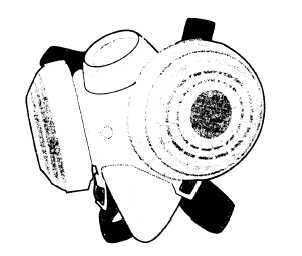| |
Fumes–Very small particles (1 micrometer or
less) formed by the condensation of volatilized solids,
usually metals. Fumes are produced from the welding,
brazing, and cutting of metals.
Gas–A material that under normal conditions of
temperature and pressure tends to occupy the entire
space uniformly. Such material includes hydrogen
sulfide gas from the collection, holding, and transfer
system; acid gas from battery charging; and ammonia
gas from deck stripping. Gases are usually invisible and
sometimes odorless.
Mist and Fog–Finely divided liquid droplets
suspended in air and generated by condensation or
atomization. A fog is a mist of enough concentration to
obscure vision. Mists are produced when you spray
solutions such as paint and spray cleaners.
Smoke–Carbon or soot particles less than 0.1
micrometer in size resulting from the incomplete com-
bustion of carbonaceous materials such as coal or oil.
Vapor (inorganic or organic)–The gaseous state
of a substance that is normally a liquid or solid at room
temperature. Vapors are produced by fuels, paints and
thinners, solvent degreasers, hydraulic fluids, and
dry-cleaning fluids.
Knowing what types of air contaminants these terms
refer to is critical to the proper selection of respirators.
For example, many people believe that paint gives off
fumes. Fumes is a common term used to describe any
smells in the air. However, fumes are actually a
condensed particle of vaporized metal given off during
welding or cutting. If you select a respirator labeled
Dust, Mist and Fumes to protect you from paint
vapors, you will not be protected. Respirator cartridges
are labeled as to the type of protection they provide.
The workplace monitoring plan or the industrial
hygiene survey will pinpoint those areas and processes
that require respirators. Since most ships carry few
exotic chemicals and have limited heavy industrial
work, they don’t need a great variety of respirators or
cartridges. Ashore, extensive industrial work may
require an activity to have a greater selection and variety
of respirators.
Identify Various Types of Respirators
You should be familiar with the three basic types of
respirators:
air-purifying, supplied-air, and
self-contained. An air-purifying respirator removes air
contaminants by filtering, absorbing, adsorbing, or
Figure 5-7.—Cartridge-type respirator.
chemical reaction. This respirator may be disposable or
have a disposable prefilter on a cartridge (fig. 5-7).
You can only use the air-purifying respirator when
the adequate oxygen (19.5 to 23.5 percent by volume)
is available and the contaminant level is not immediately
dangerous to life or health (IDLH). We classify
air-purifying respirators as follows:
Particulate-removing–These respirators have
filters that remove dusts, mists, fumes, and
smokes by physically trapping the material on the
filter surface.
Gas- and vapor-removing–These respirators
have cartridges that absorb or chemically bind
vapor or gas within the cartridge.
Combination particulate and gas- and vapor-
removing–These respirators are a combination of
the preceding two types of respirators. They are
required when you have a combination of
materials such as a particle (mist) and a vapor.
Since these air-purifying respirators are negative-
pressure respirators, they can only be used with air
contaminants that have good warning properties, such
as odor or taste. Warning properties indicate when the
mask is leaking or the cartridge is used up.
The supplied-air respirator provides breathing air
independent of the environment. You must wear this
type of respirator when the following conditions exist:
1. Contaminant does not have enough odor, taste,
or irritating warning properties
5-19
|

